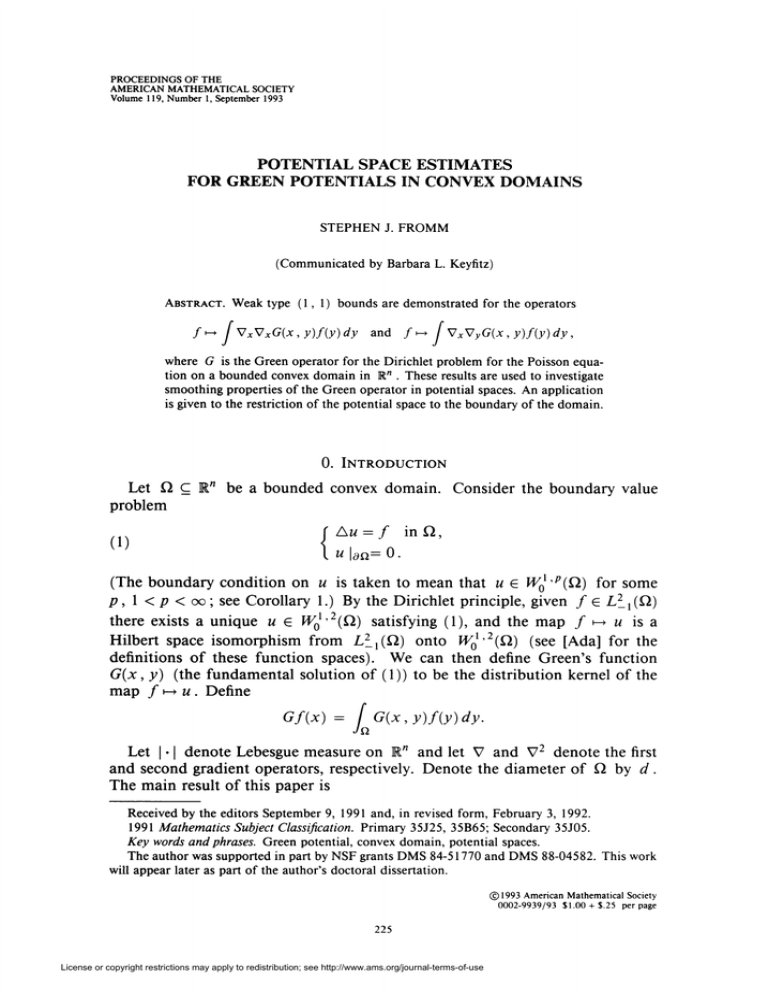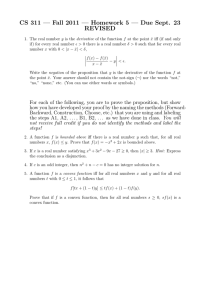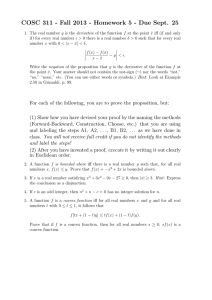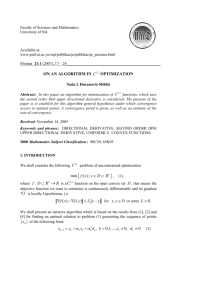U l"|»n=0. Gf(x) = f G(x,y)j(y)dy.
advertisement

proceedings of the
american mathematical society
Volume 119, Number 1, September 1993
POTENTIAL SPACE ESTIMATES
FOR GREEN POTENTIALS IN CONVEX DOMAINS
STEPHEN J. FROMM
(Communicated by Barbara L. Keyfitz)
Abstract.
/-
Weak type (1,1)
bounds are demonstrated for the operators
jvxVxG(x,y)f{y)dy
and /-» j VxVyG(x, y)f(y)dy,
where G is the Green operator for the Dirichlet problem for the Poisson equation on a bounded convex domain in K" . These results are used to investigate
smoothing properties of the Green operator in potential spaces. An application
is given to the restriction of the potential space to the boundary of the domain.
0. Introduction
Let del"
be a bounded convex domain.
Consider the boundary value
problem
f Au = f
U
infl,
l"|»n=0.
(The boundary condition on u is taken to mean that u e W0l'p(Q) for some
p, 1 < p < oo; see Corollary 1.) By the Dirichlet principle, given / e L2_X(Q.)
there exists a unique u e W0l,2(Sl) satisfying (1), and the map j ^ u is a
Hilbert space isomorphism from Li,(Q) onto W0l,2(Q.) (see [Ada] for the
definitions of these function spaces). We can then define Green's function
G(x, y) (the fundamental solution of (1)) to be the distribution kernel of the
map f >->u. Define
Gf(x) = f G(x,y)j(y)dy.
Jq
Let | • | denote Lebesgue measure on R" and let V and V2 denote the first
and second gradient operators, respectively. Denote the diameter of Q. by d.
The main result of this paper is
Received by the editors September 9, 1991 and, in revised form, February 3, 1992.
1991 Mathematics Subject Classification. Primary 35J25, 35B65; Secondary 35J05.
Key words and phrases. Green potential, convex domain, potential spaces.
The author was supported in part by NSF grants DMS 84-51770and DMS 88-04582.This work
will appear later as part of the author's doctoral dissertation.
© 1993 American Mathematical Society
0002-9939/93 $1.00+ $.25 per page
225
License or copyright restrictions may apply to redistribution; see http://www.ams.org/journal-terms-of-use
226
S. J. FROMM
Theorem. Let j e Lx (il), where il CRn is bounded and convex. Then jor all
k>0,
(2)
(3)
\{x e il : |V2(C7/)(x)| > A}| < ^1||/||L,(Q),
jxeQ:
J VxVyG{x,
y)j(y)dy >/} < £^l||/||t,(n).
The weak-type estimate (2) is an unpublished result due to Dahlberg, Verchota, and Wolff. It is a straightforward consequence of the analogous L2 result
(Lemma 1, due to Kadlec) and pointwise estimates of the gradients of G(x, y).
(Adolfsson has recently found a similar Hardy space result; see [Adol].)
The weak-type estimate (3) is new. Its proof also relies on its L2 analogue
(Lemma 2, essentially the Dirichlet principle) and estimates of gradients of
G(x, y) but is substantively different from the proof of (2). (Whereas the
standard Calderon-Zygmund-Hormander bound (10) for singular kernels is the
main step in the proof of (2), the analogous inequality for (3) fails for the planar
domain constructed in §5.) Interpolation of (2), (3), and the L2 results gives
the estimates stated as Corollary 1. These estimates have a further application
to the restriction of Lp+l/ (il) to dil when il is convex (see §4).
For s eR and 1 < p < oo , let LP(il) be the (Bessel) potential space in il,
with norm || • \\SyP. LP(il) coincides with the usual Sobolev space Ws'p(il)
when s eZ and is defined for 5 e R by the complex interpolation method (see
[Ada]).
Corollary 1. Ij He Rn is bounded and convex, and if fe
LP(il), then there is
a unique u e W0x'p(il)n LP+2(il) satisfying Au —fi, and
(4)
\\u\\s+2,P < C(d,s,p,n)\\f\\SyP
for -I < s < 0 and 1 < p < -^ (defining g = oc) and fior s = 0, p = 2.
Below, il C R" will be a bounded convex domain unless noted otherwise. C
will denote a constant whose value may change between lines and within a line.
C may depend on n but not on d, s, or p unless so indicated, and C may
depend on il only in that it may depend on d. Lp(il), LP(il), and so on will
denote the obvious function spaces for vector- and tensor-valued functions.
Note il is a Lipschitz domain but generally not a C1 domain.
1. Proof of (2)
First we state the analogous L2 result. It follows from an integration by
parts and the positivity of the second fundamental form of dil (see [G] for
details).
Lemma 1. ||V2(G/)||i2(n)
< ||/||L2(n).
We now state some pointwise estimates on G(x, y). Define
c5(x) = dist(x, Oil).
License or copyright restrictions may apply to redistribution; see http://www.ams.org/journal-terms-of-use
POTENTIALSPACEESTIMATESFOR GREEN POTENTIALSIN CONVEX DOMAINS
227
Proposition 1. Ij il is convex (but not necessarily bounded), then
(5)
(6)
\G(x, y)\ < CS(y)\x - y\x~",
\VxG(x,y)\<CS(y)\x-y\-",
(7)
\\7xG(x,y)\<C\x-y\x-n,
(8)
(9)
\VxVyG(x,y)\<C\x-y\-n,
|V2VyG(x, y)\ < C\x - y\~" l[mm(\x - y\, 8(x))].
For n > 3, (5)-(8) can be found in [GW]; (9) follows easily from (8) by the
techniques used there. When n = 2, only minor modifications need to be made
in the proofs.
Consider now the operator / >->V2(G/), which by Lemma 1 is bounded
from L2(Q) to L2(il). It may be extended to an operator K on functions on
R" with kernel K(x, y) = V2xG(x,y) for x and y e il and K(x,y) = 0 if
x or y £ il. To prove the weak-type estimate above it suffices to show the
Hormander condition
(10)
/
\K(x,y)-K(x,y0)\dx
< C
J\x-y0\>5r
for \y - yo\ < r (and C depending on neither yo e R" nor r > 0).
First assume yo e il and consider only those x in {x e il: |x - yo\ > 5r}
satisfying |x - yo\ < \S(yo) ■ (This also constrains the choice of r.) Then
|V2C7(x,y)-V2t7(x,y0)|
<\y-yo\
sup {|V/V2G(x,/)|:/
0<A<1
= Aj;+ (l-A));o}.
Since |x -y'\ < \8(x) and |x -vtj| < ||x - y'\, (9) gives
\Vy,V2C7(x,y')\ < C\x - y'\-"-x < C\x - yol-""1The left-hand
side of (10) (with domain of integration
further restricted as
above) is bounded by
cf
r\x-yo\-"-ldx
< C,
J\x-y0\>5r
completing this case.
Now consider the remaining cases: (a) yo $ il, and (b) yo e il,
\x - yo\ > j^(yo), which may be rewritten together as |x - yo\ > j dist(>>o, ilc)
(where c denotes set complement in R" ). Since |x-j>o| > 5r and |y —jvol < r,
|jc —y| > \dist(y ,£lc). Therefore for \y - y0\ < r the integral in x of
\K(x, y) - K(x, yo)\ over {|x - y0\ > max(5r,^dist(yo,Hc))}
is bounded
by the integral of ^(x,^)!
over {|x - yo\ > jdist^o, Hc)} plus that of
lA^x, y)\ over {|x - y\ > \ dist(y, ilc)}. Each of these is bounded by
(11)
sup/
\V2xG(x,y)\dx
yetl Jx£Q ,\x-y\>d(y)/4
since K(x, y) —0 for x or y $ il. To complete the proof it suffices to show
the finiteness of (11).
License or copyright restrictions may apply to redistribution; see http://www.ams.org/journal-terms-of-use
228
S. i. FROMM
Take tp e C0°°(l+) with <p(t)= 0 for t < { or t > A, and <p(t)= 1 for
1 < t < 2. Put (j)j(x) = <p(\x- y\/[2Jd(y)]). Then by the Cauchy-Schwarz
inequality,
/
|V2C(x, y)\ dx < Y f \Vx[4>j(x)G(x,
y)]\dx
Jx€n,\x-y\>d(y)/4
j=-2Jil
oo
,
.
s 1/2
< C Y [2^(^)]"/2(J IV2[^(x)C7(x,y)]\2dx)
.
Since (pj(x)G(x, y) vanishes when x e dil, (pj(-)G(-,y) = G[A(4)j(-)G(-, y))].
We may apply Lemma 1 to obtain
/ |V2[0;(x)fJ(x,y)]|2c7x<
Jn
/ |A[</>;(x)cJ(x,);)]|2</x.
Jq
Note \Ax[(l>j(x)G(x, y)]\2 < 2{G(x, >^)2|A^(x)|2 + 4|VxC(x, y)|2|V^(x)|2},
\A<t>j\< C[V8(y)]~2, and |V^| < C[V8(y)]-x. (5) implies that, for x e
supp(A^),
G(x,y) < CS(y)\x - y\x~" < Cd(y)[2Jd(y)]x~n ; similarly, (6)
implies that for x 6 supp(V^),
\VxG(x,y)\ < C5(y)[V5(y)]-n . We find
that
/ \V2x[<pj(x)G(x,y)]\2dx < C2-2J[Vd(y)]-".
Jq
So
r
qo
/
|V2C7(x,>')|<ix<C V 2-^<C,
Jx€Q,\x-y\>Sxy)/4
J=_2
finishing the proof of (2).
Remark.
Let a(y) be supported in a ball B = B(yo, r) c R" , with ||a||z.°c(ln) <
jgr and Ja(y)dy = 0. Then
/ \Ka(x)\dx<
Jw
f
JB(y0, 5r)
\Ka(x)\dx
+ f ([
\K(x,y)-K(x,yo)\dx]\a(y)\dy.
JB \J\x-y0\>5r
J
The first term on the right-hand side is bounded by using the Cauchy-Schwarz
inequality and Lemma 1; the second term is bounded using (10). We find that
(12)
f\Ka(x)\dx<C;
this is the main result of [Adol]. Note that in [Adol] the property J ady = 0
is not needed when dist(5, ilc) < C diam(i?). This is true here as well because
of the finiteness of (11). Note also that in [Adol], (12) is proved in the case of
il convex, unbounded, and lying above a Lipschitz graph of Lipschitz constant
M; the constant in [Adol] corresponding to the right-hand side of (12) depends
on M. When applied to the case of bounded il, this gives atomic and W
estimates with constants depending on the eccentricity of the domain, which is
not the case here.
License or copyright restrictions may apply to redistribution; see http://www.ams.org/journal-terms-of-use
potential space estimates for green potentials in convex domains
229
2. Proof of (3)
As before, we begin with the analogous L2 result.
Lemma 2. || /„ V*VyG(x, y)fly)dy\\ma.dx)
< C(d)\\f\\L2{a).
Prooj. Since G(x, y) vanishes as y tends to dil, we may write
/ VxVyG(x,y)j(y)dy= -Vx f G(x, y)Vyj(y)dy = -VG(V/)(x).
Jn
By the Dirichlet principle,
Jq
l|vc7(v/)||L2(fi)< \\Giyf)h,2 < C(d)\\vfU,2.
The lemma follows, since ||V/||_i,2 < H/llz^n)Now fix k > 0. Let K(x, y) = WxVyG(x, y) if x, y e il, and K(x ,y) = 0
otherwise; denote the operator corresponding to this kernel by K also.
Extend / to an element of L'(R") by putting / = 0 outside of il. By
the Calderon-Zygmund decomposition (see [St]), there are cubes Qj, j e N,
with disjoint interiors such that \j(x)\ < X a.e. in (Uf QjY , T,? \Qj\ <
fll/lli'(*")'
anc* \f\Qj - ^'
wnere (•••)c2j denotes the mean of the given
function over Qj. It is not necessary that Qj C il for all j, although since
supp/cQwe
may assume Qjilil^
0 for all j . Denote by Q* the dilation
of Qj about its center yj by a factor of 10.
Now segregate the cubes: write N = Nx U N2 , where j e Nx if diam(Qj) <
dist(Q,, Hc), and ;' e N2 if diam(Qj) > dist(Qj, ilc); j e N2 includes the
case Qj \%il.
The idea of the proof is as follows. As usual, given a cube Qj consider only
those x not in Q*. When j = 1 and \x - yfi < C8(y}), \VyK(x,y)\ <
C\x - y\~"~l for y e Qj, and the proof follows the usual method of showing
weak-type bounds for Calderon-Zygmund kernels. In the remaining cases j =
I>\x -yj\>Cd(yj),
and j -2,
x sees the mass of \j\ at Qj as being close
to dil. These cases are resolved without the use of cancellation by the estimate
\K(x, y)\ < C\x - y\~~n and the result of Sjogren [Sj] that the convolution of
|x|~" with a measure supported in a "small" set in R", like dil, is in weak
Lx(Rn).
Define g a.e. by letting g = j on (Uf Qjf , g = Jq, on Qj for j e Nx,
and g = 0 on Qj for j e N2. Define bj a.e. for j e N by bj = j - jQj on
Qj if jeNx, bj = fi on Qj if jeN2, and bj = 0 on Q). f = g + £~, bj,
and g and bs are supported in il. Clearly,
|{xgC2:|^/(x)|>a}|
(13)
< (xeQ:|A^(x)|>^}
l
l)
+ Y \xeil\\jQr.
A=i,2 {
i
K[Ybj)(x)
\jeN, J
>-4\ +[)Qj .
J
l
We bound the first and last terms of the right-hand side in the usual manner
(see [St]). By the lemma, 11^11^,,)
< C(d)\\g\\LHa). In addition, \g\ <
License or copyright restrictions may apply to redistribution; see http://www.ams.org/journal-terms-of-use
230
S. J. FROMM
CX and ||s||Li(n) < \\fih'(Q). hence
jx € H:\Kg(x)\
> \ JI < ^ J \Kg(x)\2dx
< ^l\\g\\lHn)< <M||/||1I(Q).
Also,|UrG;i<10nEriG;l<fll/k.(fl)Consider now the summand / = 1 in the third term of (13). Define functions
Xj and Aj by putting Xj{x) = 1 if x e H\Q*j and |x -y7-| < 10<5(ja_,-),
and
Xj(x) - 0 otherwise. Let A_,-(x)=1 if x e il and |x - yj\ > 10<5(.y;),and
Aj(x) = 0 otherwise. Fix j and suppose Xj{x) = I for now. Since bj has
mean value 0 when j e Nx, Kbj(x) = J[K(x, y) - K(x, yj)]bj(y) dy . For
yeQj,
\K(x,y)-K(x,yj)\
< diam(G,-)supj,,eQ.\Vy.K(x,y')\. Since y' e Q,
and ; e Nx imply |x - y'\ < C5(y'), it follows from (9) that \Vy-K(x, y')\ <
C\x-y'\-"-x
< C\x - yfi-"-1. Hence
\Kbj(x)\ < Cdiam(f2,)|x-^r"-1||^||il(^)
when Xj(x) = 1- Since diam(Qj) J,Q.)C\x -yj\~"~[ dx < C,
Y [Xj(x)\Kbj(x)\dx
<CY WbjWv
< C\\f\\may
By Markov's inequality, \{x:J^JeNl Xj{x)\Kbj(x)\ > |}| < xl|/||z,.(n). To finish
estimating the size of the i = 1 term in (13), it suffices to show that
lx:Y^(x)\Kbj(x)\>^\
<j\\f\\v(ay
Inequality (8) implies \K(x,y)\ < C\x - y\~". When ;' e Nx, Aj(x) = 1,
and y e Qj, \x —y\~n < C\x -Pj\~n,
where Pj e dil
is chosen satisfying
dist(pj, Qj) = dist(dil, Qj) for j e N (if j e N2,pj is possible in Qj).
Hence
(14)
Aj(x)\Kbj(x)\<cj\x-pJ\-"\bJ(y)\dy
= C\x-pJ\-"\\bJ\\V{Q).
Define a measure p with support in dil by
M= Y IIMi'toA,>
j€N,
where 8Pj is the unit point mass at p}. Let r~" he the function z ^ \z\" on
R". Then by (14)
Y Aj(x)\Kbj(x)\ <Cr~n*p,
jeN,
where * is convolution on R" . By a theorem of Sjogren (see [Sj]),
i x : Y *j(x)\Kbj(x)\> ^ I < \{x: r~" *p(x) > CX]\
c
c
c
< ymass(^) = j Y Wbjh'(Q)
< jll/llz.>(n)jeN,
License or copyright restrictions may apply to redistribution; see http://www.ams.org/journal-terms-of-use
POTENTIAL SPACE ESTIMATESFOR GREEN POTENTIALS IN CONVEX DOMAINS
231
(The constant arising from the application of Sjogren's result to dil may be
taken as uniform over all convex il C R" .)
The i = 2 summand of the third term of (13) is treated in the same manner
as Eygjv,Aj(x)\Kbj(x)\, because j e N2, Qjtlil^ 0, x e il\Q*, and y e Qj
imply (with (8)) \K(x,y)\ < C\x - y\~n < C\x-pj\~n.
That bj does not
necessarily have vanishing mean value when j e N2 makes no difference.
3. Proof of Corollary
1
Let / G Lp(il). We first show that Gf e Lp+2(il) and that (4) holds for
u = Gj.
Applying the real interpolation method to (2) and Lemma 1 gives
||V2(C/)||o,P < C(p)\\j\\o,p, 1 < p < 2. (5) and Young's inequality show
that ||C/||o,r, < C(d)\\f\\o,p. Similarly, (7) and Young's inequality show that
l|V(Cr/)||o,p'< Cd\\f\\0,p. Hence (4) holds for s = 0 and 1 <p < 2.
Remark. When il is not convex, Corollary 1 may fail for s = 0. For example,
Jerison and Kenig [JK] found a bounded C1 domain il with / g C0do(Q), yet
V2(C/) i Lx(il).
We now consider (4) for s = -1, 1 < p < oc . Suppose / G Z/,(Q). Note
that there exists an h G Lp(il) with / = divh, and ||b.||i,(n) < C(d)\\f\\-XyP.
Fors = -l we need only show ||C(divh)||liP < C(d, p)\\h\\Lp(Q)> 1 < P < co.
As in the proof of Lemma 2, C(divh)(x) = —JQVvG(x, y) • h(y)dy . It is
therefore enough to show that
f VxVyG(x,y)h(y)dy
Jd
W(Q;dx)
+ f VyG(x,y)h(y)dy
Jn
L»{Q;dx)
< C(rf,p)||/l||^(C2)
(where for simplicity of notation we have replaced h by a scalar-valued h ).
Real interpolation, (3), and Lemma 2 imply
(15)
[ VxVyG(x,y)h(y)dy
Jn
LP(n-dx)
< C(d, p)\\h\\mQ),
Kp<2.
Since VxV^C7(x, y) - VyVxG(y, x), duality shows that (15) holds in the range
1 <p <oc. That || JclVyG(x,y)h(y)dy\\Ll,{Q.dx} < C(d, p)\\h\\Ll,{a;dX) f«r
1 < p < oo follows from (7) and Young's inequality.
Inequality (4) holds for Gf for the other 5 and p indicated in Corollary 1
by complex interpolation.
Because G is bounded from Z/,(Q) to Lp (il), to see that Gf e Wx-"(il),
it is enough to check it for / in the dense subclass L°°(il). For / e L°°(il),
(5) and (7) imply that Gf(x), VGj(x), and S(x)-lGf(x) are bounded, from
which it easily follows that Gf G W0X
'p(il) for any p, 1 < p < oo .
Suppose u e W0l'p(il) and Am = 0. Given xp e C0°°(Q), JuAxpdx =
J Auxpdx - 0. The uniqueness asserted in Corollary 1 follows, since C^°(il)
is dense in W0l>p'(il), A takes W}'"'(il) onto z/,(Q),and
Z/',(ft) is the
dual of Wx'p(ii) (where p'~x +p~x = 1 ).
Remark. When il is only Lipschitz and s = -1 , the estimate (4) holds for
some p ^ 2 but not all p, 1 < p < oc (see [JK]). (The case p — 2 is just the
Dirichlet principle.)
License or copyright restrictions may apply to redistribution; see http://www.ams.org/journal-terms-of-use
232
S. J. FROMM
Remark. The theorem and Corollary 1 also hold for il bounded, globally Lipschitz, and satisfying a uniform exterior sphere condition. The above proofs are
essentially unchanged. Lemma 1 has been shown in this greater generality by
Adolfsson (see [Ado2]); Lemma 2 relies only on the Dirichlet principle. Proposition 1 is stated in [GW] in this generality (and the case n = 2 still holds);
and for the application of Sjogren's result it suffices that il be globally Lipschitz. Here, the constants in (2), (3), and (4) will depend on more geometric
information about il, such as the radius given in the uniform exterior sphere
condition.
4. AN APPLICATION TO RESTRICTION OF SOBOLEV SPACES
If il is only C1 , it can be shown that Corollary 1 fails for p = 2, s = -\ ;
Jerison and Kenig derive this from the failure of L2/2(il) to restrict to L2(dil)
[JK]. If il is convex, we may reverse this logic and show that the restriction
L2/2(C2)- L2(dil) holds. Indeed,
Corollary 2. Ij il is convex and bounded and 1 < p < oo, then the trace oj
Lp+l/p(il) to dil is the same as the trace oj HLp+l/p(il) = {v : Av = 0, v e
Proof Let F e Lp+l/p(il). By Corollary 1, G(AF) e Lp+l/pnW0l<p(il). Hence
C7(AF)|an = 0 in the sense of, e.g., LP(dil), and F\dn = (F - G(AF))\dii.
Remark. When p = 2 and il is Lipschitz, 77L2/2(Q)|9cj= L2(dil) (see [JK]).
Therefore if il is convex, L2,2(r2)|^Q = L2(dil).
5. A COUNTEREXAMPLE
Proposition 2. There is a bounded convex il c R" and an f e C°°(il)
such
that Gj tf. LP+2(il) for any p, s with p > ^ , -1 < s < 1, 1 < p < oo.
Without loss of generality take p near -^y. Pick ro << 1. Let il be
the image of {z G C:|z| < ro, Im(z) > 0} under the conformal mapping
0:z h-» -zlogz,
where the branch of log is chosen so that Imlogz lies in
(0, n) when z is in the upper half plane, il lies in the upper half plane and
is convex and bounded. Let *P = <I>_' : il -» C and put u = n lm *F, where n
is the restriction to il of a function in C03O(C)which is 1 in a neighborhood
of the origin and is supported very close to the origin (so that u vanishes on
dil). Put / = Au. fi is supported away from the origin and is C°°(r2), and
Gf = u . For (x, y) near the origin, |Vw(x, y)\ = |*r"(to)|, where w = x + iy
and
4"(ttf) = <p'-x(*¥(w)) =-.
K '
( K "
l+log¥(w)
As w -► 0 G dil, 4" -► 0.
If Vw G Cn(il)
for some a > 0, we must
therefore have |4"(i(;)| = \Vu(x, y)\ < C\w\". But a simple calculation shows
that |»F'| > C|logM|-'
as w -> 0, hence Vm £ C"(H) for any a > 0.
This shows that u <£ LP+2(il) for p > £r, -1 < s < 1. For otherwise Vm g
LPS+X(H)
C Cs+x-2'p(il) (see [T, Theorem 4.6.1(e)]).
This example is adapted to aa> 3 by adding extra variables and cutting off.
License or copyright restrictions may apply to redistribution; see http://www.ams.org/journal-terms-of-use
potential space estimates for green potentials in convex domains
233
References
[Ada]
R. A. Adams, Sobolev spaces, Academic Press, New York, 1975.
[Adol] V. Adolfsson, LP-integrability of the second order derivatives of Green potentials in convex
domains, Pacific J. Math, (to appear).
[Ado2] _,
L2-integrability of second order derivatives for Poisson's equation in nonsmooth do-
mains, Math. Scand. 70 (1992), 146-160.
[G]
P. Grisvard, Elliptic problems in nonsmooth domains, Pitman, Boston, MA, 1985.
[GW]
M. Griiter and K.-O. Widman, The Green function for uniformly elliptic equations, Manus-
cripta Math. 37 (1982), 202-342.
[JK]
[Sj]
D. Jerison and C. E. Kenig, The functional calculus for the Laplacian on Lipschitz domains,
preprint.
P. Sjogren, Weak Lx characterizations
of Poisson integrals, Green potentials, and Hp
spaces, Trans. Amer. Math. Soc. 233 (1977), 179-196.
[St]
E. M. Stein, Singular integrals and differentiability properties of functions, Princeton Univ.
Press, Princeton, NJ, 1970.
[T]
H. Triebel, Interpolation theory, function spaces, differential operators, North-Holland, New
York, 1978.
Department of Mathematics, Massachusetts
Institute of Technology, Cambridge.
Massachusetts 02139
Current address: Department of Mathematics and Statistics, McMaster University, 1280 Main
Street West, Hamilton, Ontario, Canada L8S 4K1
E-mail address: sjfromm@icarus.math.mcmaster.ca
License or copyright restrictions may apply to redistribution; see http://www.ams.org/journal-terms-of-use





